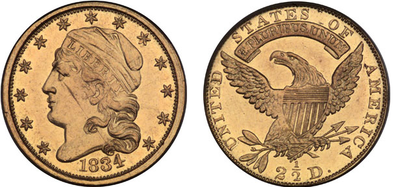
Quarter Eagle
Encyclopedia

Designed by Robert Scot
Robert Scot
Robert Scot was the first Chief Engraver of the United States Mint from its inception in 1793 until his death in 1823. He was succeeded by William Kneass.-Early life:...
, the quarter eagle denomination
Denomination (currency)
Denomination is a proper description of a currency amount, usually for coins or banknotes. Denominations may also be used with other means of payment like gift cards. See also Redenomination.-Subunit and super unit:...
was struck at the main mint
Mint (coin)
A mint is an industrial facility which manufactures coins for currency.The history of mints correlates closely with the history of coins. One difference is that the history of the mint is usually closely tied to the political situation of an era...
at Philadelphia
Philadelphia Mint
The Philadelphia Mint was created from the need to establish a national identity and the needs of commerce in the United States. This led the Founding Fathers of the United States to make an establishment of a continental national mint a main priority after the ratification of the Constitution of...
, and branch mints in Charlotte
Charlotte Mint
The Charlotte Mint was a branch of the United States Mint that came into existence on March 3, 1835 during the Carolina Gold Rush. The first gold mine in the United States was established in North Carolina at the Reed Gold Mine...
(1838-1859 not inclusive), New Orleans
New Orleans Mint
The New Orleans Mint operated in New Orleans, Louisiana, as a branch mint of the United States Mint from 1838 to 1861 and from 1879 to 1909. During its years of operation, it produced over 427 million gold and silver coins of nearly every American denomination, with a total face value of over...
(1838-1857 only), Dahlonega
Dahlonega Mint
The Dahlonega Mint was a branch of the United States Mint. It was located at 34°31.8′N 83°59.2′W at Dahlonega, Lumpkin County, Georgia. Coins produced at the Dahlonega Mint bear the "D" mint mark. That mint mark is used today by the Denver Mint, which opened many years after the Dahlonega Mint...
(1839-1859), and in later years, San Francisco
San Francisco Mint
The San Francisco Mint is a branch of the United States Mint, and was opened in 1854 to serve the gold mines of the California Gold Rush. It quickly outgrew its first building and moved into a new one in 1874. This building, the Old United States Mint, also known affectionately as The Granite Lady,...
(1854-1879) and Denver
Denver Mint
The Denver Mint is a branch of the United States Mint that struck its first coins on February 1, 1906. The mint is still operating and producing coins for circulation, as well as mint sets and commemorative coins. Coins produced at the Denver Mint bear a D mint mark...
(1911-1925). The first issues weighed 67.5 grains, fineness .9167, until the weight was modified to 64.5 grains and the fineness changed to .8992 by the Act of June 28, 1834. The Act of January 18, 1837 established a fineness of .900. This means that 1837 and later Quarter Eagles contain 0.121 Troy Oz. of gold content.
As relatively fewer coin
Coin
A coin is a piece of hard material that is standardized in weight, is produced in large quantities in order to facilitate trade, and primarily can be used as a legal tender token for commerce in the designated country, region, or territory....
s were struck prior to 1834, combined with their higher gold content (promoting melting for their bullion content), all of the early issues range from scarce to rare. The first issues were struck in 1796. Any proof date prior to 1856 is rare, and will command a premium in any condition. The quarter eagle denomination was officially discontinued in 1933 with the removal of the United States from the Gold Standard, although the last date of issue was 1929.
List of designs
- Turban Head (1796–1807)
- Draped Bust (1808)
- Capped Head (1821–1834)
- Classic HeadClassic Head Quarter EagleThe classic head $2.50 gold coin is an American coin, also called a Quarter Eagle, minted from 1834-1839.-Economic Conditions:1834 witnessed tough economic times in the United States. President Andrew Jackson was opposed to the developing central bank of that era known as the Second Bank of the...
(1834–1839) - Liberty Head (Coronet) (1840–1907)
- Indian Head (1908–1915, 1925–1929)
External links
- US Quarter Eagle by year and type. Histories, photos, and more.

